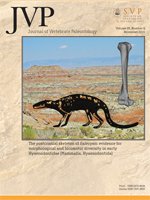Computed tomographic scan data of three premaxillae, a maxilla, and a dentary of Dicraeosaurus hansemanni allow reconstruction of the tooth replacement pattern in this taxon. Four or five replacement teeth are present in each of the four tooth families of the premaxilla. The interalveolar septum is labially interrupted, and an alveolar trough is formed. In the maxilla, the number of replacement teeth decreases in a caudal direction from four to one per tooth family. The dentary bears 16 alveoli, and the number of replacement teeth decreases caudally from three to one per tooth family. Replacement rates are around 20 days for the premaxillary and rostral maxillary teeth of Dicraeosaurus, which confirms the presence of high tooth replacement rates in Diplodocoidea. Replacement teeth of the dentary are less than half as large as those of the upper jaw, and replacement rates are around 50 days for the rostral dentary teeth. Hypothetical reconstruction of Zahnreihen yields a potential z-spacing of 1 with simultaneous front-to-back tooth replacement. Most probably, the rostralmost teeth in Dicraeosaurus were used for food acquisition, whereas the more caudally positioned teeth served only as a guide and as a lateral limit for the food within the mouth. The teeth of the dentary were less prone to wear than those of the upper jaws. These findings are in agreement with the reconstructions of Dicraeosaurus as a selective mid-height browser.
How to translate text using browser tools
1 November 2015
Dentition and Tooth Replacement of Dicraeosaurus hansemanni (Dinosauria, Sauropoda, Diplodocoidea) from the Tendaguru Formation of Tanzania
Daniela Schwarz,
Jens C. D. Kosch,
Guido Fritsch,
Thomas Hildebrandt
ACCESS THE FULL ARTICLE





